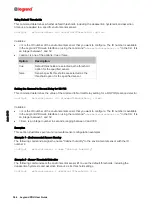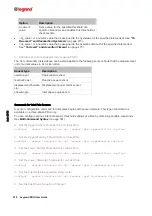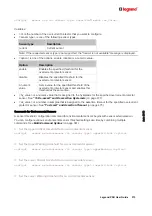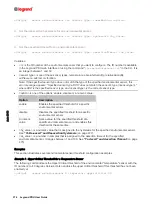
Ju
ne
20
18
376 Legrand PDU User Guide
Actuator Configuration Commands
An actuator configuration command begins with
actuator
. You can configure the name and location
parameters of an individual actuator.
You can configure various parameters for one actuator at a time. See
Multi-Command Syntax
(on page
381).
Change the name:
config:#
actuator <n> name "<name>"
Set the X coordinate:
config:#
actuator <n> xlabel "<coordinate>"
Set the Y coordinate:
config:#
actuator <n> ylabel "<coordinate>"
Set the Z coordinate:
config:#
actuator <n> zlabel "<z_label>"
Modify the actuator's description:
config:#
actuator <n> description "<description>"
Variables:
<n> is the ID number assigned to the actuator. The ID number can be found using the Legrand PDU web
interface or CLI. It is an integer starting at 1.
<name> is a string comprising up to 64 ASCII printable characters. The <name> variable must be
enclosed in quotes when it contains spaces.
<coordinate> is a string comprising up to 24 ASCII printable characters, and it must be enclosed in
quotes.
There are two types of values for the <z_label> variable, depending on the Z coordinate format you set:
Type
Description
Free form
<coordinate> is a string comprising up to 24
ASCII printable characters, and it must be
enclosed in quotes.
Rack units
<coordinate> is an integer number in rack units.
Note: To specify the Z coordinate using the rack units, see
Setting the Z Coordinate Format for
Environmental Sensors
(on page 298).
<description> is a sentence or paragraph comprising up to 64 ASCII printable characters, and it must be
enclosed in quotes.
Example - Actuator Naming
The following command assigns the name "Door lock" to the actuator whose ID number is 9.
config:#
actuator 9 name "Door lock"
















































